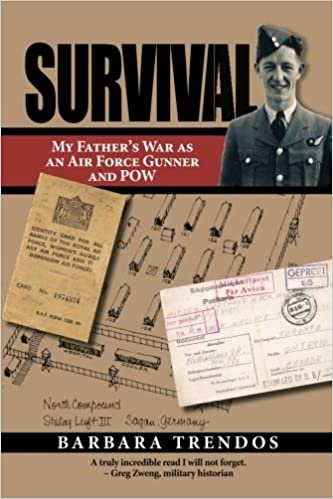
A boy who’d become a man by joining the Royal Canadian Air Force and graduating as an air gunner (second highest marks in his class), marched to the harbourfront in Halifax on a fall day in 1942. Albert Wallace boarded the ocean liner Queen Elizabeth – transformed by the war into a troopship – and prepared for the transatlantic crossing to Britain to join the Allied air war effort over Europe. He figured the Queen E couldn’t be hit by U-boat torpedoes. She was a lucky ship.
“I know luck,” he wrote in his diary that day, Oct. 27, 1942. “I’ll never forget the close call I had trying to stop my CCM (bike) by jamming my foot against the front tire. I ended up flying ass-over-teakettle over the handlebars onto the streetcar tracks (in Toronto).”
 The notion that youth enjoys a sense of invincibility was just as common in RCAF officer Albert Wallace’s time as today. This week, I re-read my copy of Survival: My Father’s War as Air Force Gunner and POW by Wallace’s daughter, Barbara Trendos.
The notion that youth enjoys a sense of invincibility was just as common in RCAF officer Albert Wallace’s time as today. This week, I re-read my copy of Survival: My Father’s War as Air Force Gunner and POW by Wallace’s daughter, Barbara Trendos.
Incorporating Wallace’s diary entries and letters home, Barbara’s book retraces her father’s path during the war, when everybody was supposed to step up and do his part despite the odds of wartime mortality. Coincidentally, this week, a lot of young people in Toronto expressed a related fearlessness by gathering in parks, not physical distancing and ignoring the threat of potentially acquiring or spreading the coronavirus. That’s one form of invincibility.
Pilot Officer Al Wallace’s Second World War experience was clearly another. My long-time friend and RCAF veteran Albert Wallace died this week at Sunnybrook Hospital – not from COVID-19 – in his 100th year.
Miraculously, Al defied the odds again and again during the war. As he trained at the bombing and gunnery school near Jarvis, Ont., indeed on his 22nd birthday – Sept. 9, 1942 – a crash at the training base killed a pilot and two of Al’s fellow students. Throughout the rest of that year, P/O Wallace prepared for service in Bomber Command, and the operational flights that would put him in the thick of the air war over Nazi-occupied Europe night after night.
In one of his pre-bombing sessions, Wallace received instruction in the use of an escape kit – containing Dutch currency, a compass, jack-knife, Horlicks tablets (milk powder mix) and a cloth map of Europe – should his bomber be shot down. “Hope I never need it,” he wrote afterwards.
He would need it. Despite the success rate of his RCAF 419 Moose Squadron – flying the most sorties with the fewest losses among its bomber crews – on May 12/13, 1943, during his 15th bombing mission, Al’s Halifax bomber encountered heavy anti-aircraft flak over Germany. This sparked fires in its fuel tanks and his pilot, W/O Glen “Mac” McMillan, gave the order to abandon the aircraft.
Though not a praying man, Al said a prayer just as the slipstream pulled him through his escape hatch in the bomber into the night air. He pulled the D-ring of his parachute; it blossomed as he watched his bomber, now a ball of fire, crash to Earth. McMillan and the wireless operator died in the crash helping the others to survive, including Al Wallace who ended up in Stalag Luft III, the German POW camp famous for the Great Escape.
Despite threats of reprisals for attempting to escape, Wallace joined the escape committee and operated as a penguin, carrying tunnel dirt in pouches to the camp theatre.
“Was told to load up and go see Arsenic and Old Lace at the theatre,” he wrote. “Sat in seat 13 in the back row. … During the show, a trapdoor quietly opened under my feet. That was my clue to let go my load.” P/O could have put his name in the draw for those to escape through Tunnel Harry on March 24, 1944. He chose not to. He sensed that youthful invincibility would not get him across Germany as an escapee.
Instead, in the final months of the war, he and thousands of other POWs endured a forced winter march westward through blizzards and cold; he was released just before VE Day, 75years ago this month, to return to Canada, marry, raise a family and live a full 100 years of life.

As the world spins madly through a global pandemic, and some of us either choose to walk close to others in sheer defiance of law and common sense, I think of centenarian Albert Wallace, who learned how to face wartime menace that was potentially fatal. He beat the odds of combat survivability with some luck, yes, but also by recognizing his own limitations and mortality. He went on to a century service to his family, his community and his country.
His is a lesson in acquired wisdom, not blind invincibility, something we could all use a bit more of these days. Rest in peace, Al.
Thanks so much for this lovely post Ted. Dad would be honoured.
I had the privilege of meeting Mr. Wallace one evening in Lindsay. He came and spoke about his service and his time imprisoned in Germany at a local gathering put together by his niece Janice and her husband Bernard Finney.
He was well spoken and very interesting to talk to one on one afterwards.
Ted Barris also spoke to a group at the Lindsay Library shortly after I met Mr Wallace.
Another fine speaker and gentleman.
It was my privilege to meet both men.